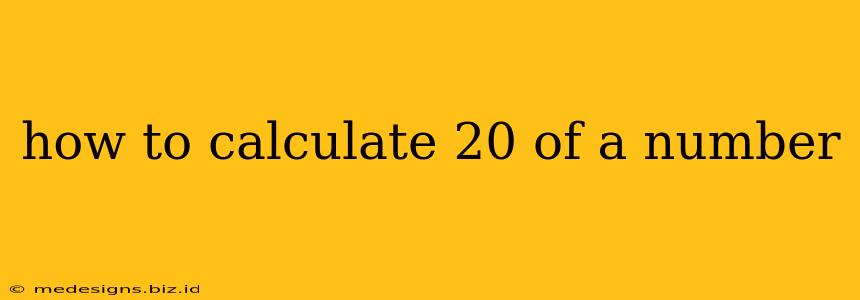Finding 20% of a number is a fundamental skill with applications in various aspects of life, from calculating discounts to understanding financial statements. This guide provides several straightforward methods to help you master this calculation.
Method 1: Using the Decimal Equivalent
The most common and efficient way to calculate 20% of a number is to convert the percentage to its decimal equivalent and then multiply.
Here's how:
-
Convert the percentage to a decimal: To convert a percentage to a decimal, divide it by 100. Therefore, 20% becomes 20/100 = 0.20.
-
Multiply the decimal by the number: Multiply the decimal equivalent (0.20) by the number you want to find 20% of.
Example: Let's find 20% of 150.
- 20% = 0.20
- 0.20 * 150 = 30
Therefore, 20% of 150 is 30.
Method 2: Using Fractions
Percentages can also be expressed as fractions. 20% is equivalent to the fraction 20/100, which simplifies to 1/5.
Here's how to use this method:
-
Simplify the fraction: Reduce the fraction 20/100 to its simplest form, which is 1/5.
-
Divide by the denominator: Divide the number by the denominator of the simplified fraction. In this case, divide the number by 5.
-
Multiply by the numerator: Multiply the result by the numerator of the simplified fraction (which is 1 in this case). This step is unnecessary if the numerator is 1, as the result from step 2 is already the answer.
Example: Let's find 20% of 150 again using this method.
- 20% = 1/5
- 150 / 5 = 30
Therefore, 20% of 150 is 30. This method is particularly helpful when dealing with percentages that have easily simplified fractions, like 25% (1/4), 50% (1/2), and 75% (3/4).
Method 3: Using a Calculator
Calculators provide the simplest approach for calculating percentages. Most calculators have a percentage button (%) which automates the process.
How to use a calculator:
-
Enter the number: Key in the number you want to find 20% of.
-
Multiply by 20: Multiply the number by 20.
-
Press the percentage button (%): This will automatically divide the result by 100, giving you the 20% value.
Alternatively, you can directly input the calculation as number * 20 / 100.
Practical Applications of Calculating 20%
Calculating 20% is useful in many real-world scenarios:
- Sales tax: Many regions have a sales tax of around 20%, making this calculation vital for budgeting.
- Discounts: Stores often offer 20% discounts, so knowing how to calculate this helps you determine the final price.
- Tips: Calculating a 20% tip in a restaurant is easier using these methods.
- Profit margins: Businesses use 20% as a benchmark for profit margins.
- Commission: Sales representatives often receive a 20% commission on sales.
Mastering the calculation of 20% empowers you to make informed financial decisions and handle everyday percentage problems confidently. Choose the method that best suits your preference and mathematical comfort level.
